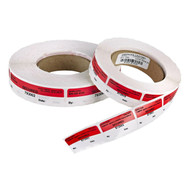5 Reasons Why Airports and Airlines Rely on Security Labels and Tape
Posted by Steve Diebold
Commercial, private, cargo, ground, and on-board aircraft, as well as military and civilian activities, all have different security needs and requirements. In most cases, you may find all of these services at the same time at a major airport. Other airports, such as smaller private fields, military or government installations, and commercial shipping airports, may only provide a subset of these services.
All of these separate security activities are carried out in accordance with laws and rules set forth by the Federal Aviation Administration, the Department of Homeland Security, the Transportation Security Administration, and so on. In the aviation industry, tamper evident adhesive labels are required in almost all installations. Below are just five of the many critical reasons why you should use security labels or tapes in the aviation industry:
1. Cargo and Luggage Security
Cargo planes frequently utilize adhesive security tape to seal packages. Tape can adapt to the wide variety of cargo carried by airplanes. Because air cargo has a diverse variety of goods packed in standard containers together with various commodities that do not fit in typical airline shipping containers, it is more difficult to secure than ocean containers and vehicles. This group includes things like pallets, crates that are big or oddly shaped, machinery, large parts, and so on.
Security tape adhesives can be tailored to different cargo surfaces, such as timber boxes or plastic pallet wrap. To make it obvious whether the tape has been removed, security labels typically include a VOID message in the adhesive as well as serial numbers and other identifiers written at regular intervals. This enables a security indication to be shown upon contact and may be used to assign a unique identifier to an item.
While most bags are examined and packed with standard labels under the supervision of the air carrier, some bags and extra luggage are treated like cargo and must be recognized and secured in the same way. When this is the case, security tape is an ideal option because it can be applied and removed without damaging the item being sealed.
2. Safety for Everyday Use Items
Food, drink, medication, paper goods, culinary utensils, disposable products, and more are transported on board an aircraft and stored in sealed containers, boxes, or carts. While some catering carts utilize security labels, others use mechanical seals that may be broken. Remember that when a container doesn't have a padlock seal or another way to seal it mechanically, like a hasp with a hole, it must have a label.
3. Regulating Aircraft Entry
Adhesive security labels were first used in aviation to seal airplane doors. While the plane is unattended on the runway or in the hangar, knowing that no one has broken in or entered other openings is crucial. When a security label is removed, a distinct message indicating that the item has been opened or is otherwise invalid is shown. Also, if airport rules require it, the date and time of sealing and opening can be indicated.
Interestingly, the need for such labels stemmed in part from the rise in private aviation. This kind of label is often referred to as "non-residue" adhesive. A non-residue adhesive was created so that the aircraft's surface wouldn't have to be cleaned after each label was removed. Today, this type of secure adhesive is widely used across a wide variety of businesses and applications.
4. Access Management at Airports and Terminals
Controlling and keeping track of who has access to different types of secure closures is made easier with the use of tamper evident seals or tape. All sorts of items need to be kept safe, including those involved in air traffic control, security, maintenance, terminal quality control, hospitality services, and more. Ticketing supplies and machines, information terminals, monitors, and a variety of access doors and panels related to the airport's mechanical systems that are not often opened are some of the things that need to be stored.
5. Protection for Onboard Safety Equipment
Portable oxygen tanks, medical emergency kits, special signaling and illumination systems, rafts, and other emergency gear are among the many types of safety equipment that is checked, inspected, and sealed inside airplane compartments. Important safety equipment on board often has a security label that the person in charge of installing and checking the equipment must sign and date.
Let us help you out. Seals from American Casting & Manufacturing are available in bulk quantities over the phone, and in smaller quantities with expedited shipping through their website at www.seals.com. Our New York facility is well-known for its speedy service and reaction times in cases of AOG emergencies.
Or, if you have any questions about using seals in the aviation industry or any other industry, AC&M's specialists are here to help. We have extensive experience in every market and in every application imaginable. For over a century, we've provided vital services to the nation's civilian and armed forces establishments. If you have any questions about seals, please email info@seals.com or call 1-866-304-4289 in the United States or 516-349-7010 internationally to speak with a seal expert.

